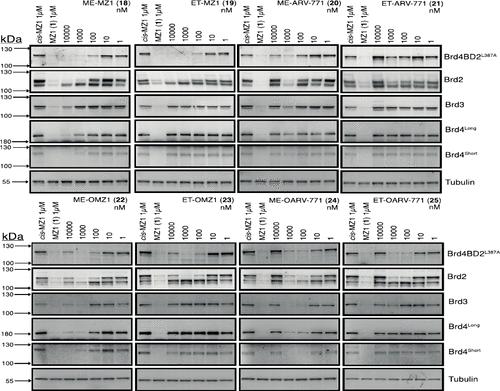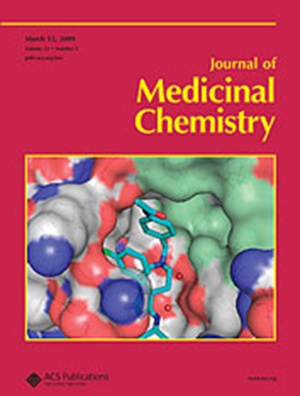更正“BromoTag的开发:一种“Bump-and-Hole”-PROTAC系统,可诱导标记靶蛋白的有效、快速和选择性降解”
IF 6.8
1区 医学
Q1 CHEMISTRY, MEDICINAL
引用次数: 0
摘要
我们注意到图5中的两个Western blot图,即ET-OMZ1(23)和ET-OARV-771(25)的“Brd4短”通道是相同的。这是由于在从相应的未裁剪的斑点中选择面板时犯了一个诚实的错误。从相关的补充图(图S7,第16页的支持信息)中可以清楚地看出这一点,该图显示了用于准备最终图5的所有全长未裁剪的印迹。图中已更正,为ET-OMZ1(23)“Brd4 short”对应的正确面板。化合物ET-OARV-771(25)对应的“Brd4 short”面板是正确的,因此不需要更改。认识到这个问题后,我们决定再次检查所有材料,并发现了其他一些小问题。我们发现ME-OARV-771(24)的“Brd4 short”面板也被错误地从相应的未裁剪的印迹中选择(参见支持信息第16页相同的相关补充图S7)。现在这个问题已经得到了纠正。我们还发现,ET-MZ1 (19), ME-ARV-771(20)和ET-ARV-771(21)的“微管蛋白”面板被错误地切割为显示8个车道而不是7个车道,在面板的最右侧保留了一个额外的无关车道。我们现在已经将这些面板拆下,以移除这条车道。图5与更正面板如上所示。这些错误不影响数据分析和结论。第15496页(右栏中间)。BromoTag载体供体的模板主干的身份被错误地引用为“pcDNA5”。正确的矢量是“pMK-RQ”,如下所示。用Fugene HD转染试剂(Madison, Wisconsin,美国)或lipofectamine 2000 (Madison, Wisconsin,美国)同时转染HEK293细胞,同时转染三种定制载体,包括含有U6-snRNA和Cas9D10A表达盒的px335载体(Addgene),含有另一个U6-sgRNA和purromycin表达盒的pBABED载体(MRC PPU, Dundee University),最后是含有eGFP-P2A-BromoTag-Brd2供体敲入序列的pMK-RQ载体。第15498页(左栏底部)。使用的组织培养板的大小被错误地引用为“100cm”。正确的尺寸如下“10cm”处理前24 h,将crispr修饰的BromoTag-Brd2 HEK293细胞(5 × 106)接种于10 cm板上。我们已经修改了支持信息,以增加文本来澄清每个实验进行的生物重复数量(n)。我们现在也意识到,支持信息第24页补充图9右上方的PROTAC AGB1(46)的“Brd4抗体”面板(以及相应的微管蛋白加载控制)来自同一实验的不同生物重复,而不是相应的主要文本图(图6,第15489页)中选择的生物重复。这已在支持信息中更正。我们还检测到在第27页的辅助信息中,补充图15中的“cis-MZ1”和“MZ1(1)”标签不小心被调换了。这已在支持信息中更正。支持信息可在https://pubs.acs.org/doi/10.1021/acs.jmedchem.5c00108免费获取。BromoTag degron组分的DNA序列分析结PCR;杂合子BromoTag-Brd2 Hek293细胞株中eGFP-P2A-BromoTag全长的基因分型PROTACs 18-25对Brd4长、短、Brd3、Brd2和Brd4BD2 L387A的蛋白降解谱;Brd4BD2 L387A和Brd2的AGB1(46)、AGB2(47)和AGB3(48)蛋白降解谱;原始的未裁剪的Western blot图像;化合物46 ~ 48和52的HPLC-HRMS痕量分析化合物46-48和52的核磁共振光谱(PDF)更正“BromoTag的开发:一个“凹凸孔”- protac系统诱导有效,快速和选择性降解标记目标蛋白”2视图0共享0下载大多数电子支持信息文件可在没有订阅ACS网络版的情况下使用。这些文件可以通过文章下载用于研究用途(如果相关文章有公共使用许可链接,该许可可以允许其他用途)。如有其他用途,可通过RightsLink权限系统http://pubs.acs.org/page/copyright/permissions.html向ACS申请。这篇文章尚未被其他出版物引用。本文章由计算机程序翻译,如有差异,请以英文原文为准。

Correction to “Development of BromoTag: A “Bump-and-Hole”–PROTAC System To Induce Potent, Rapid, and Selective Degradation of Tagged Target Proteins”
It has come to our attention that two of the Western blot panels in Figure 5, namely, the “Brd4 short” lanes for ET-OMZ1 (23) and ET-OARV-771 (25) were the same. This arose as a result of an honest mistake when choosing panels used from the corresponding uncropped blots. This is clear from the relevant Supplemental Figure (Figure S7, page 16 in the Supporting Information), which shows all the full-length uncropped blots that were used to prepare the final Figure 5. The figure has been corrected and shows the correct panel corresponding to “Brd4 short” for ET-OMZ1 (23). The panel corresponding to “Brd4 short” for compound ET-OARV-771 (25) was correct and thus did not require changes. Having recognized this issue, we decided to go over ALL the material again and found a few other minor issues. We discovered that the “Brd4 short” panel for ME-OARV-771 (24) was also incorrectly chosen from the corresponding uncropped blot (see the same relevant Supplemental Figure S7, on page 16 in the Supporting Information). This has now been corrected. We have also found that the “tubulin” panels for ET-MZ1 (19), ME-ARV-771 (20) and ET-ARV-771 (21) were incorrectly cropped to show 8 lanes instead of the 7 in question, keeping an additional irrelevant lane on the far right of the panels. We have now recropped these panels to remove this lane. Figure 5 with the corrected panels is shown above. The data analysis and conclusions are not affected by these mistakes. Page 15496 (middle of right column). The identity of the template backbone of the BromoTag vector donor was incorrectly quoted as “pcDNA5”. The correct vector is “pMK-RQ” as follows. HEK293 cells were transfected using a Fugene HD transfection reagent (Madison, Wisconsin, United States) or lipofectamine 2000 (Madison, Wisconsin, United States) simultaneously with three custom vectors including a px335 vector (Addgene) containing a U6-snRNA and Cas9D10A expression cassette, a pBABED vector (MRC PPU, Dundee University) harboring another U6-sgRNA and puromycin expression cassette, and finally a pMK-RQ vector containing an eGFP-P2A-BromoTag-Brd2 donor knock-in sequence. Page 15498 (bottom of left column). The size of the tissue culture plate used was incorrectly quoted as “100 cm”. The correct size is “10 cm” as follows. CRISPR-modified BromoTag-Brd2 HEK293 cells (5 × 106) were seeded on a 10 cm plate 24 h before treatment. We have revised the Supporting Information to add text to clarify the number of biological replicates (n) that were performed for each experiment. We have now also realized that the “Brd4 antibody” panel for PROTAC AGB1 (46) at the top right of Supplementary Figure 9 on page 24 in the Supporting Information (and the corresponding tubulin loading control) was from a different biological replicate of the same experiment than the one chosen in the corresponding main text figure (Figure 6, on page 15489). This has now been corrected in the Supporting Information. We also detected that the labels “cis-MZ1” and “MZ1 (1)” in Supplementary Figure 15 on page 27 in the Supporting Information were swapped accidentally. This has now been corrected in the Supporting Information. The Supporting Information is available free of charge at https://pubs.acs.org/doi/10.1021/acs.jmedchem.5c00108. DNA sequences of BromoTag degron components; junction PCR; genotyping of the span of eGFP-P2A-BromoTag in the heterozygous BromoTag-Brd2 Hek293 cell line; protein degradation profiles of PROTACs 18–25 for Brd4 long, Brd4 short, Brd3, Brd2, and Brd4BD2 L387A; protein degradation profiles of AGB1 (46), AGB2 (47), and AGB3 (48) for Brd4BD2 L387A and Brd2; original uncropped Western blot images; HPLC-HRMS traces for compounds 46–48 and 52; NMR spectra for compounds 46–48 and 52 (PDF) Correction
to “Development of BromoTag: A “Bump-and-Hole”–PROTAC
System To Induce Potent, Rapid, and Selective Degradation of Tagged
Target Proteins” 2 views 0 shares 0 downloads Most electronic Supporting Information files are available without a subscription to ACS Web Editions. Such files may be downloaded by article for research use (if there is a public use license linked to the relevant article, that license may permit other uses). Permission may be obtained from ACS for other uses through requests via the RightsLink permission system: http://pubs.acs.org/page/copyright/permissions.html. This article has not yet been cited by other publications.
求助全文
通过发布文献求助,成功后即可免费获取论文全文。
去求助
来源期刊

Journal of Medicinal Chemistry
医学-医药化学
CiteScore
4.00
自引率
11.00%
发文量
804
审稿时长
1.9 months
期刊介绍:
The Journal of Medicinal Chemistry is a prestigious biweekly peer-reviewed publication that focuses on the multifaceted field of medicinal chemistry. Since its inception in 1959 as the Journal of Medicinal and Pharmaceutical Chemistry, it has evolved to become a cornerstone in the dissemination of research findings related to the design, synthesis, and development of therapeutic agents.
The Journal of Medicinal Chemistry is recognized for its significant impact in the scientific community, as evidenced by its 2022 impact factor of 7.3. This metric reflects the journal's influence and the importance of its content in shaping the future of drug discovery and development. The journal serves as a vital resource for chemists, pharmacologists, and other researchers interested in the molecular mechanisms of drug action and the optimization of therapeutic compounds.
 求助内容:
求助内容: 应助结果提醒方式:
应助结果提醒方式:


